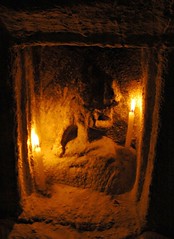Synthesis of Buddhist-Saiva and Sakta Tantras
Jha, Surendra:
Synthesis of Buddhist-Śaiva and Śākta Tantras : an unknown Siddhapīṭha Maluti / Surendra Jha. - Delhi : Pratibha Prakashan, 2009. - xviii, 142 S. : Ill., Kt.
ISBN 81-7702-197-4
Rs. 1850,00
US$ 40,22 (Eastern Book Corp.)
US$ 90,00 (Bagchee)

(Bildquelle: Flickr)
Beschreibung
The present work is primarily intended to make an endeavour to introduce an unknown but unique village, Maluti located in the interiors of Santal Parganas in Jharkhand. It had been the centre of Vajrayana Tantric Sadhana in an age when Buddhism had already been swept away from India, i.e. after the fall of the university of Vikramsila. Not only that the village Maluti developed an unique religious culture which is the synthesis of Buddhist, Saiva and Sakta Tantric Sadhana. We find Vajrayana (Sarasvati) being fully assimilated with Saivism (Ganga) and Saktism (Yamuna) and all the three being synthesized in the presiding Goddess of the village-Devi Mauliksa.
Thus, Devi Mauliksa is unique in the sense that she is simultaneously a Vajrayani-Pauranika and Sakta Tantric deity.
Not only this, the village had to its credit 108 temples of which 76 are still standing. There are 63 Siva temples with Siva-linga enshrined. These Siva temples have Vajradanda on their Sikhara, instead of a Trisula or Trident - another example, par excellence, of the rare synthesis of Vajrayana and Saivism.
The hut-style architecture of the temples is a class in itself which has been termed by us as Maluti style, as distinct from Birbhum and Bankura styles. Terracotta art of each temple is superb and they are neither wall paintings nor stuccoes rather they have been pasted on the wall with Vajralepa, a paste made from local herbs, sand and different other ingredients. Terracotta paintings depicting Ramalila and Krsnalila and other Vaisnava themes are yet another example of synthesis.
The narrative of the village is fascinating reflecting the Indian ethos of 'diversity in unity' as well as 'continuity and change'. We hope that the students of philosophy, Tantra, religion, art and culture as well as anthropology, sociology and history will find it useful. And Clio, the muse of history, will be satisfied. [Vom Buchumschlag]
Inhalt
Acknowledgements
Preface
1. Introduction
2. Historical geography
3. Location of the village Maluti and its surroundings
4. Political history of Maluti Raja - reconstructed
5. Basic principles of Saiva, Sakta and Buddhist Tantras philosophical perspective
6. Identification of Devi Mauliksa
7. Siddha-Pitha Maluti
8. Temple architecture in ancient and medieval India
9. Siva temples of Maluti
10. Terracotta
Appendices
Bibliography
Glossary
Index.
Autor
SURENDRA JHA, SKM (Sidho Kanho Murmu) University, Dumka, Department of History.
Quellen: Bagchee; Vedams Books; Eastern Book Corp.
